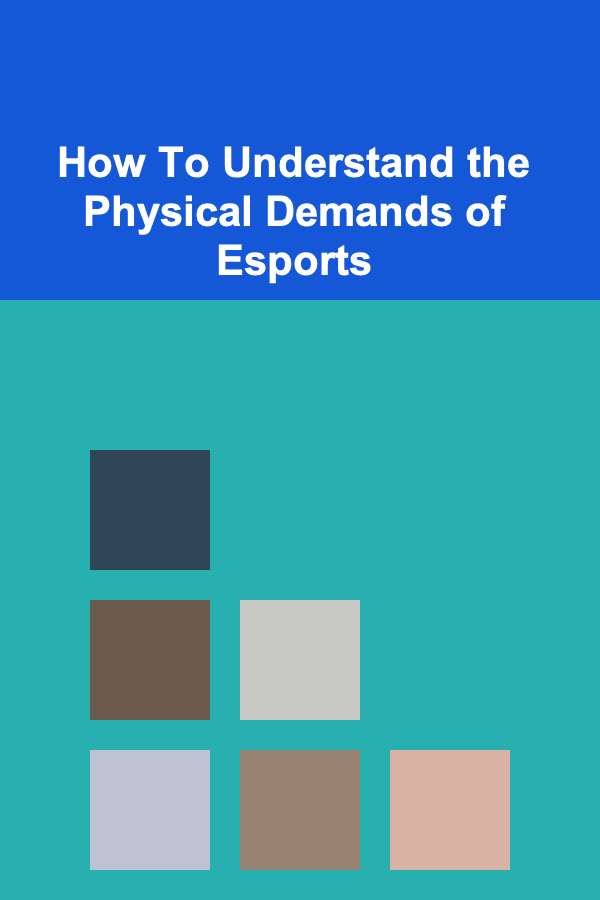
How To Understand the Physical Demands of Esports
ebook include PDF & Audio bundle (Micro Guide)
$12.99$10.99
Limited Time Offer! Order within the next:

Esports, often seen as the digital counterpart to traditional sports, has rapidly grown in popularity, attracting millions of players and spectators worldwide. While much of the focus tends to be on the mental and strategic elements of esports, there's a growing recognition of the physical demands placed on professional players. Unlike traditional sports, which are often associated with physical endurance, coordination, and strength, esports requires a different set of physical capabilities that are crucial to a player's performance. In this article, we will explore the physical demands of esports, examining the unique aspects of gameplay that require physical skills, the potential health implications, and strategies for maintaining physical health while competing at the highest levels.
The Nature of Esports and the Role of Physicality
Esports, or competitive video gaming, involves professional players competing in video game tournaments across a variety of genres, including strategy, first-person shooters, and sports simulations. While these games are fundamentally different from traditional sports, they still require a high degree of precision, reaction time, and endurance, all of which can be considered physical demands in their own right.
Hand-Eye Coordination and Reflexes
One of the most fundamental physical demands in esports is hand-eye coordination. Players must be able to react quickly to in-game stimuli, often under immense pressure. The games are fast-paced, and a single millisecond delay can make the difference between winning and losing. For instance, in games like "League of Legends," "Counter-Strike: Global Offensive," or "Overwatch," players need to track multiple elements on the screen simultaneously while making split-second decisions on movements and attacks.
The ability to control a mouse or controller with precision while processing complex information rapidly is a skill that requires both mental and physical acuity. Unlike traditional sports, where the body moves in physical space, in esports, players use their hands and fingers in highly specific ways, often for extended periods.
Endurance and Stamina
Esports players often compete in long tournaments that can last several hours or even days. These prolonged sessions place significant physical demands on players. While there is no running or physical exertion like in traditional sports, players must maintain focus and mental acuity throughout these long hours of play. Mental fatigue and physical strain are closely linked; as the body becomes tired, so does the mind, which can impair decision-making, reaction times, and overall performance.
The requirement for sustained attention, quick reflexes, and strategic thinking across extended periods of time can lead to both mental and physical exhaustion. This is why stamina in esports is just as crucial as in traditional sports, though it manifests in different forms.
Posture and Musculoskeletal Strain
A lesser-discussed but increasingly recognized aspect of esports is the physical strain caused by poor posture and repetitive movements. Professional esports players spend a considerable amount of time sitting in front of screens, often in positions that can lead to musculoskeletal issues. Sitting for prolonged periods in front of a computer, especially in poorly designed chairs, can lead to back pain, neck strain, and carpal tunnel syndrome.
The physical demands of esports are not just about the hands and fingers. The arms, wrists, shoulders, neck, and lower back are all engaged and susceptible to strain due to the constant use of a mouse, keyboard, or controller. Over time, these repetitive motions can result in overuse injuries, which are common in other fields that require repetitive, strenuous movements.
Reaction Time and Cognitive Load
In esports, players often need to make decisions in fractions of a second. Reaction time in esports is crucial and is linked to the physical ability to perform actions as quickly as possible. In games like "Fortnite" or "Call of Duty," a player's ability to aim, shoot, and move fluidly is tied to how quickly their brain processes the information and directs their hands to execute the action.
While this is a mental demand, it is also very physical because it involves physical motion (e.g., moving the mouse, pressing keys, or moving the controller) with high precision and speed. Reaction time is often trained through practice, but it can be physically draining due to the intensity of these rapid movements.
Health Implications of the Physical Demands in Esports
With the rising prominence of esports, there has been a growing concern about the long-term health impacts on players. The physical demands, though different from traditional sports, can still lead to significant health issues if not managed properly.
Vision Problems
The excessive time spent staring at screens can lead to a host of vision-related issues. Players often experience digital eye strain, which includes symptoms like dry eyes, headaches, and blurred vision. This is compounded by the intense focus required during gameplay, which means players may not blink as frequently as they should, leading to further eye strain.
To combat these issues, many players use strategies like the 20-20-20 rule (looking at something 20 feet away for 20 seconds every 20 minutes) and maintain proper lighting to reduce glare. Additionally, players may wear specialized glasses designed to filter blue light and reduce eye strain.
Mental Fatigue and Stress
While mental acuity is a key part of esports, mental fatigue is an equally significant concern. The psychological strain of maintaining focus and strategic thinking for long periods can lead to stress, anxiety, and burnout. In high-stakes tournaments, the pressure to perform can exacerbate mental health issues, leading to a decrease in performance and overall well-being.
Mental fatigue can also manifest physically, with players experiencing muscle tension, headaches, or an overall sense of exhaustion. To address these challenges, many esports organizations have begun integrating mental health support into their training regimens, including access to psychologists, stress-management techniques, and mindfulness practices.
Musculoskeletal Disorders
As mentioned earlier, the repetitive nature of the movements required in esports can lead to musculoskeletal disorders. These conditions, which include carpal tunnel syndrome, tendinitis, and back pain, are common in players who do not take proper care of their bodies. Extended periods of sitting with poor posture can cause significant strain on the neck, back, and shoulders.
To combat these issues, players are encouraged to take regular breaks, stretch, and adjust their sitting posture. Ergonomic chairs and equipment are also crucial in reducing the risk of injury. Some teams even employ physiotherapists to help players maintain optimal physical health and prevent injuries.
Training for Physical and Mental Health in Esports
While esports may not require the same kind of physical conditioning as traditional sports, players still need to focus on their physical health to perform at their best. Just as athletes in traditional sports undergo rigorous physical training, esports athletes can benefit from structured physical and mental training regimens.
Physical Conditioning
Though esports players do not need to run marathons or lift heavy weights, physical conditioning is still crucial. Cardiovascular exercise, such as running or cycling, can improve overall stamina and energy levels. Strength training can help prevent injuries, particularly in the shoulders, wrists, and lower back, areas that are especially vulnerable to strain in esports.
Flexibility exercises, including stretching and yoga, are also important for preventing muscle tightness and improving posture. Esports players can also benefit from exercises designed to strengthen the hands and wrists, which are under constant strain due to the repetitive motions of gaming.
Mental Training and Focus
Mental training is just as important as physical training in esports. Players need to maintain peak cognitive performance throughout long gaming sessions, and this requires mental discipline, focus, and relaxation techniques.
Meditation, mindfulness, and breathing exercises can help players manage stress and maintain their mental clarity during intense competition. Visualization techniques, where players imagine themselves successfully executing in-game strategies, can also improve focus and reduce anxiety.
Incorporating regular sleep schedules, healthy eating habits, and stress-reduction techniques into the daily routine can greatly enhance cognitive function and performance.
Rest and Recovery
Rest and recovery are crucial for esports players. Just like traditional athletes, players need adequate sleep to recover both physically and mentally. Chronic sleep deprivation can impair reaction time, decision-making, and hand-eye coordination, all of which are essential for high-level esports performance.
Active recovery, such as light physical activity or stretching, can also help reduce muscle stiffness and prevent injuries. It is essential for players to understand that recovery is just as important as practice to maintain long-term health and performance.
Conclusion
Understanding the physical demands of esports is key to recognizing the full scope of what it takes to succeed in the world of competitive gaming. While esports may not require the same physical strength or stamina as traditional sports, it places unique demands on players in terms of hand-eye coordination, reaction time, posture, and endurance. The long hours of gameplay can lead to mental fatigue and physical strain if not managed properly, making it crucial for players to prioritize their physical and mental health.
Esports organizations are beginning to recognize the importance of integrating physical training, mental health support, and injury prevention into their training regimens. With proper care, players can improve their performance and reduce the risk of long-term health issues. By acknowledging the physical demands of esports, players can not only achieve success in competitions but also ensure their health and well-being for the long term.

10 Smart Strategies for Lowering Car Insurance Premiums
Read More
How to Set Your Rates for Data Entry or Text Conversion Projects
Read More
How to Choose the Right Exercise for Your Body Type
Read More
10 Tips for Running in Hot Weather
Read More
10 Tips for a Weekly To-Do List for Students
Read More
10 Essential Tools for Medical Writers
Read MoreOther Products

10 Smart Strategies for Lowering Car Insurance Premiums
Read More
How to Set Your Rates for Data Entry or Text Conversion Projects
Read More
How to Choose the Right Exercise for Your Body Type
Read More
10 Tips for Running in Hot Weather
Read More
10 Tips for a Weekly To-Do List for Students
Read More